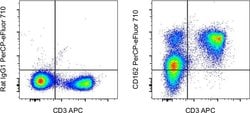missing translation for 'onlineSavingsMsg'
Learn More
Learn More
CD162 (PSGL-1) Monoclonal Antibody (4RA10), PerCP-eFluor™ 710, eBioscience™, Invitrogen™
Rat Monoclonal Antibody
Brand: Affymetrix eBioscience 46-1621-80
Additional Details : Weight : 0.01000kg
Description
CD162 (PSGL-1) is a 120 kDa homodimer protein found on the surface of leukocytes and platelets. CD162 is known to bind CD62P (P-selectin), CD62L (L-selectin), and to a lower degree CD62E (E-selectin). These interactions play a critical role in leukocyte adhesion, rolling and extravasation. CD162 has been shown to be an important immune marker of T cell exhaustion in chronic viral infections and cancer.Specifications
| CD162 (PSGL-1) | |
| Monoclonal | |
| 0.2 mg/mL | |
| PBS with 0.09% sodium azide; pH 7.2 | |
| Q62170 | |
| SELPLG | |
| Mouse PSGL-1 human IgG1 fusion protein | |
| 25 μg | |
| Primary | |
| Mouse | |
| Antibody | |
| IgG1 κ |
| Flow Cytometry | |
| 4RA10 | |
| PerCP-eFluor 710 | |
| SELPLG | |
| CD162; CLA; Cutaneous lymphocyte associated antigen; cutaneous lymphocyte-associated associated antigen; leukocyte cell surface adhesion molecule; P-selectin glycoprotein ligand 1; P-selectin glycoprotein ligand 1 propeptide; P-selectin glycoprotein ligand-1; Psgl1; Psgl-1; Selectin P ligand; selectin, platelet (p-selectin) ligand; Selp1; SELPG; Selpl; SELPLG | |
| Rat | |
| Affinity chromatography | |
| RUO | |
| 20345 | |
| 4° C, store in dark, DO NOT FREEZE! | |
| Liquid |
